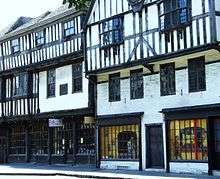Gloucester Life
Gloucester Life is a museum which is housed in two of the oldest buildings in the City of Gloucester, a Tudor merchant's house and a 17th-century town house. The museum, at 99–103 Westgate Street, is devoted to the social history of Gloucestershire.

The museum in 2010
Bishop Hooper is said to have lodged in the buildings now occupied by the museum the night before he was burned at the stake in front of St Mary de Lode Church in 1555.[1]
The Museum was called Gloucester Folk Museum before rebranding itself in 2016.[2]
Exhibits
Exhibits include:
- Local crafts
- Items relating to the River Severn fisheries
- Historic costumes
- A reconstructed Victorian classroom
- A reconstruction of the pin factory that once operated on the premises
- Displays relating to domestic life over the last 500 years
Selected publications
- Taylor. Guide to the Collection of Bygone Agricultural Instruments. 1950.
- Gloucester Folk Museum: A Guide to the Collections. 1963. (New edition, Chris Morris, 1986.)
- Morris, Christopher I. Dairy Farming in Gloucestershire. 1983.
See also
- The Museum of Gloucester
- List of museums in Gloucestershire
References
- Gloucester Folk Museum. livinggloucester.co.uk Retrieved 9 September 2011.
- "Gloucester museums unveil major rebrand and name changes". Gloucester Citizen. 21 March 2016. Retrieved 2 April 2016.
| Wikimedia Commons has media related to Folk Museum, Gloucester. |
This article is issued from Wikipedia. The text is licensed under Creative Commons - Attribution - Sharealike. Additional terms may apply for the media files.